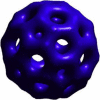Differential geometry based multiscale models
- PMID: 20169418
- PMCID: PMC2914853
- DOI: 10.1007/s11538-010-9511-x
Differential geometry based multiscale models
Abstract
Large chemical and biological systems such as fuel cells, ion channels, molecular motors, and viruses are of great importance to the scientific community and public health. Typically, these complex systems in conjunction with their aquatic environment pose a fabulous challenge to theoretical description, simulation, and prediction. In this work, we propose a differential geometry based multiscale paradigm to model complex macromolecular systems, and to put macroscopic and microscopic descriptions on an equal footing. In our approach, the differential geometry theory of surfaces and geometric measure theory are employed as a natural means to couple the macroscopic continuum mechanical description of the aquatic environment with the microscopic discrete atomistic description of the macromolecule. Multiscale free energy functionals, or multiscale action functionals are constructed as a unified framework to derive the governing equations for the dynamics of different scales and different descriptions. Two types of aqueous macromolecular complexes, ones that are near equilibrium and others that are far from equilibrium, are considered in our formulations. We show that generalized Navier-Stokes equations for the fluid dynamics, generalized Poisson equations or generalized Poisson-Boltzmann equations for electrostatic interactions, and Newton's equation for the molecular dynamics can be derived by the least action principle. These equations are coupled through the continuum-discrete interface whose dynamics is governed by potential driven geometric flows. Comparison is given to classical descriptions of the fluid and electrostatic interactions without geometric flow based micro-macro interfaces. The detailed balance of forces is emphasized in the present work. We further extend the proposed multiscale paradigm to micro-macro analysis of electrohydrodynamics, electrophoresis, fuel cells, and ion channels. We derive generalized Poisson-Nernst-Planck equations that are coupled to generalized Navier-Stokes equations for fluid dynamics, Newton's equation for molecular dynamics, and potential and surface driving geometric flows for the micro-macro interface. For excessively large aqueous macromolecular complexes in chemistry and biology, we further develop differential geometry based multiscale fluid-electro-elastic models to replace the expensive molecular dynamics description with an alternative elasticity formulation.
Figures


Similar articles
-
A multiscale model for virus capsid dynamics.Int J Biomed Imaging. 2010;2010:308627. doi: 10.1155/2010/308627. Epub 2010 Mar 9. Int J Biomed Imaging. 2010. PMID: 20224756 Free PMC article.
-
Multiscale Multiphysics and Multidomain Models I: Basic Theory.J Theor Comput Chem. 2013 Dec;12(8):10.1142/S021963361341006X. doi: 10.1142/S021963361341006X. J Theor Comput Chem. 2013. PMID: 25382892 Free PMC article.
-
Variational multiscale models for charge transport.SIAM Rev Soc Ind Appl Math. 2012;54(4):699-754. doi: 10.1137/110845690. Epub 2012 Nov 8. SIAM Rev Soc Ind Appl Math. 2012. PMID: 23172978 Free PMC article.
-
Protein electrostatics: a review of the equations and methods used to model electrostatic equations in biomolecules--applications in biotechnology.Biotechnol Annu Rev. 2003;9:315-95. doi: 10.1016/s1387-2656(03)09010-0. Biotechnol Annu Rev. 2003. PMID: 14650935 Review.
-
The Poisson-Boltzmann equation for biomolecular electrostatics: a tool for structural biology.J Mol Recognit. 2002 Nov-Dec;15(6):377-92. doi: 10.1002/jmr.577. J Mol Recognit. 2002. PMID: 12501158 Review.
Cited by
-
Divide-and-conquer strategy for large-scale Eulerian solvent excluded surface.Commun Inf Syst. 2018;18(4):299-329. doi: 10.4310/CIS.2018.v18.n4.a5. Epub 2018 Nov 26. Commun Inf Syst. 2018. PMID: 31327932 Free PMC article.
-
Multiscale molecular dynamics using the matched interface and boundary method.J Comput Phys. 2011 Jan 20;230(2):435-457. doi: 10.1016/j.jcp.2010.09.031. J Comput Phys. 2011. PMID: 21088761 Free PMC article.
-
Differential geometry based solvation model I: Eulerian formulation.J Comput Phys. 2010 Nov 1;229(22):8231-8258. doi: 10.1016/j.jcp.2010.06.036. J Comput Phys. 2010. PMID: 20938489 Free PMC article.
-
A multiscale model for virus capsid dynamics.Int J Biomed Imaging. 2010;2010:308627. doi: 10.1155/2010/308627. Epub 2010 Mar 9. Int J Biomed Imaging. 2010. PMID: 20224756 Free PMC article.
-
High-order fractional partial differential equation transform for molecular surface construction.Mol Based Math Biol. 2013 Jan 1;1:10.2478/mlbmb-2012-0001. doi: 10.2478/mlbmb-2012-0001,. Mol Based Math Biol. 2013. PMID: 24364020 Free PMC article.
References
-
- Abaid N, Eisenberg RS, Liu W. Asymptotic expansions of i-v relations via a Poisson–Nernst–Planck system. SIAM J. Appl. Dyn. Syst. 2008;7:1507–1526.
-
- Abraham FF, Broughton JQ, Bernstein N, Kaxiras E. Spanning the continuum to quantum length scales in a dynamic simulation of brittle fracture. Europhys. Lett. 1998;44:783–787.
-
- Akiyama R, Hirata F. Theoretical study for water structure at highly ordered surface: effect of surface structure. J. Chem. Phys. 1998;108:4904–4911.
-
- Alavi S, Wei GW, Snider RF. Chain relations of reduced distribution functions and their associated correlation functions. J. Chem. Phys. 1997;108:706–714.
-
- Ashbaugh HS. Convergence of molecular and macroscopic continuum descriptions of ion hydration. J. Phys. Chem. B. 2000;104(31):7235–7238.
Publication types
MeSH terms
Substances
Grants and funding
LinkOut - more resources
Full Text Sources

